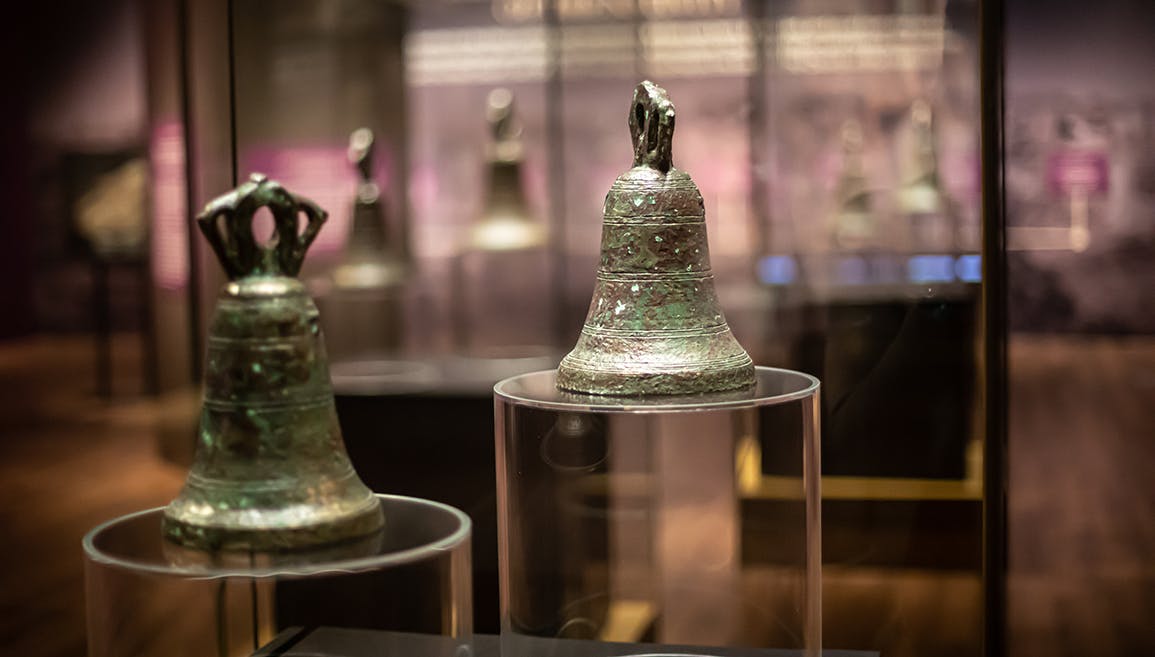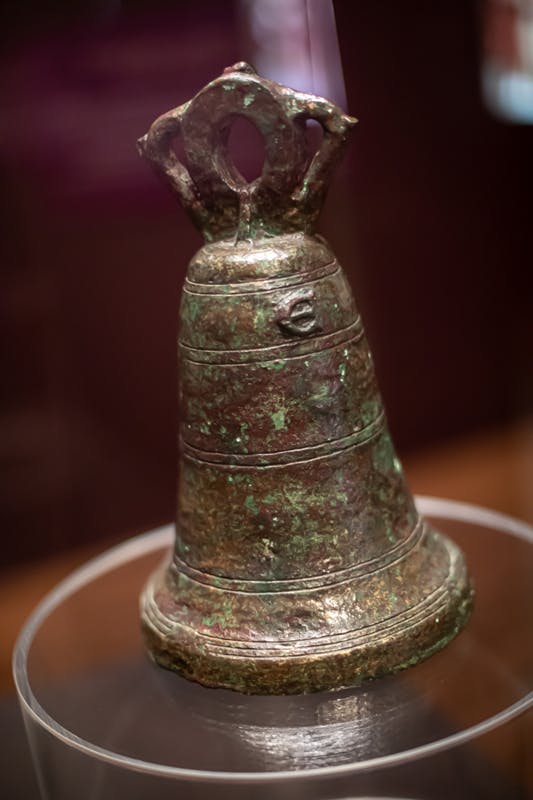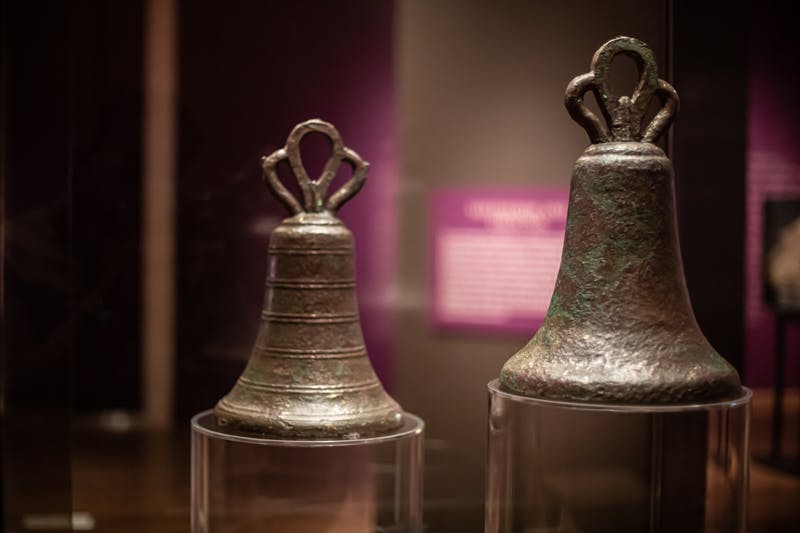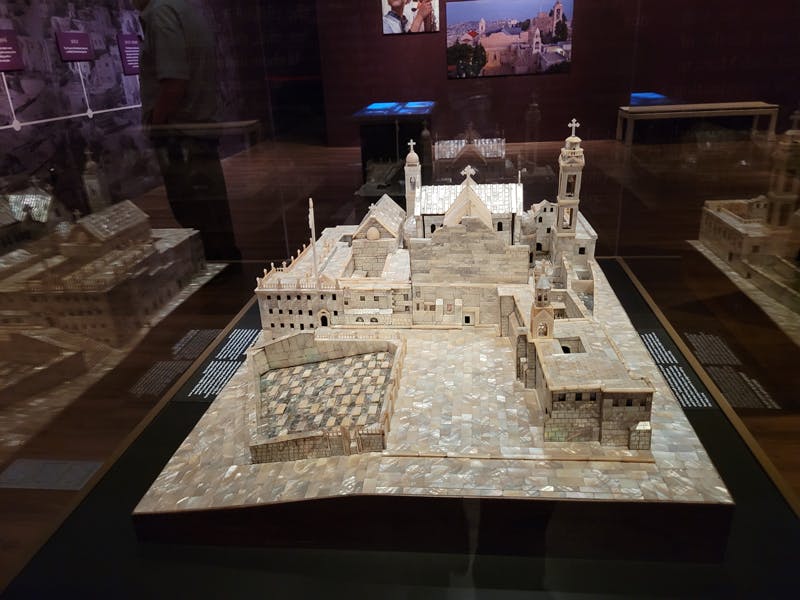Ringing in the Season

Popular Christmas music rings in the holiday season with songs ranging from “Jingle Bells” and “Silver Bells” to “Ding Dong Merrily on High” and “Carol of the Bells.” The joyous sounds of church bells pealing and sleigh bells jingling through the cold December air evokes the spirit of Christmas.
In harmony with this spirit, Museum of the Bible presents its newest exhibition, Bells of Bethlehem: Sounds from the Church of the Nativity. The exhibition features artifacts never displayed in the United States—six medieval bells and a century-old scale model of the Church of the Nativity. Museum guests can also play videos to hear modern church bells ringing for Christmas services in Bethlehem and watch excerpts from a Christmas concert in Manger Square. To tie everything together, one wall displays the Christmas narrative, Luke 2:1–20, and another presents a timeline summarizing the history of the Church of the Nativity from the fourth century to the present. Since Constantine the Great (r. AD 306–337) ordered the construction of a basilica over the grottos where tradition said Jesus was born and lay in a manger, the Church of the Nativity has been the center of Christian worship in Bethlehem.

Figure 1: View of the Bells of Bethlehem: Sounds from the Church of the Nativity exhibit. The timeline is in the background. Image © Museum of the Bible, 2022. All rights reserved.
The six bronze bells date to the twelfth century and were likely imported from Western Europe into the Holy Land during the Crusader era. No two bells are exactly alike. They range in size from 15.75″ to 10.4″ in height and from 29.5 lbs. to 15.4 lbs. in weight. The two smallest bells have crosses on one side and a letter of the alphabet (a and e respectively) on the other.

Figure 2: One of the smallest bells, marked with the letter e. Image © Museum of the Bible, 2022. All rights reserved.
All except the tallest have rings around them.

Figure 3: The two largest bells. Note the largest bell, on the right, does not have rings around it. Image © Museum of the Bible, 2022. All rights reserved.
At one time, the bells were part of a carillon incorporated into a pipe organ inside the Church of the Nativity. (What’s a carillon? Visit this link to hear a present-day carillon and see how it is played.) This carillon originally contained thirteen bells arranged in two overlapping ranks. Together, the ranks produced tones covering slightly more than a full octave. Imagine what it must have sounded like in the Church of the Nativity as the pipe organ and carillon accompanied medieval liturgical chants!
Sometime between the middle of the thirteenth and fifteenth centuries, somebody carefully dismantled the organ and carillon, patiently wrapped the 13 bronze bells and 225 lead organ pipes and buried them near the Church of the Nativity. This treasure lay undisturbed until construction within the church’s Franciscan compound in 1863 and 1906 unearthed it. Today, the pipes and bells are the property of the Terra Sancta Museum in Jerusalem, which is preparing a space for them. After the Bells of Bethlehem exhibition at Museum of the Bible ends, the bells will return home for permanent display.
For centuries, Christian-Palestinian master craftsmen in Bethlehem created beautiful artifacts decorated with mother-of-pearl. The Franciscans encouraged this craft as a way to help support the Christian community of Bethlehem through the sale of souvenirs to pilgrims and tourists. One such master craftsman was Yousef Zoughbi (1878–1964), who created the extraordinary scale model of the Church of the Nativity out of olive wood and mother-of-pearl in 1936.

Figure 4: The east face of the Church of the Nativity model, showing the apse. Image © Museum of the Bible, 2022. All rights reserved.
Zoughbi’s attention to recreating the details of the church’s construction suggests he relied upon architectural drawings first published in 1935. Under the exhibition lighting, the model gleams, and as you walk beside it, the mother-of-pearl glimmers in shades of white, pink, and green. Zoughbi painstakingly recreated the interior of the church, with the entry to the grottos and four rows of delicate columns that help support the roof.

Figure 5: The interior of the Church of the Nativity model. Note the four rows of columns and the entry to the grotto. Image © Museum of the Bible, 2022. All rights reserved.
For many years, this model sat in a souvenir store in Jerusalem, where tourists posed to have their picture taken with it.

Figure 6: The west face of the Church of the Nativity model. This is the door through which parishioners enter. Image © Museum of the Bible, 2022. All rights reserved.
The model then disappeared until Mr. George Al Ama of Bethlehem rediscovered it and had it carefully restored to its pristine state. Mr. Al Ama graciously loaned the model to Museum of the Bible for this exhibition so it could be seen in the United States for the first time.
The exhibition was made possible through the assistance of the Custodia Terrae Sanctae and the Terra Sancta Museum in Jerusalem, the Bethlehem Development Foundation, the American Friends of the Bethlehem Development Foundation, Frère Stepháne, OFM, Dr. Khouloud Daibes, and Mr. George Al Ama.
It is the first of two planned exhibits highlighting the history of the basilica and its Christian congregations who worship there. Next year, the museum hopes to host Bethlehem Reborn, a traveling exhibition focused on the church (a UNESCO World Heritage Site), its history, and its astounding restoration from 2013–2020.
The Bells of Bethlehem: Sounds from the Church of the Nativity exhibition will be at Museum of the Bible until January 29, so be sure to visit before it ends—this will be the last time the bells can be seen in the US!
By Brian Hyland, Senior Curator


